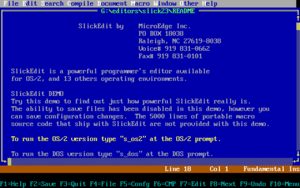SlickEdit: Difference between revisions
mNo edit summary |
mNo edit summary |
||
| Line 1: | Line 1: | ||
{{Software | |||
|Name=SlickEdit | |||
|Version=2.3 (1993) | |||
|Vendor=Microedge Inc. | |||
|Author=J. Clark Maurer | |||
|Licence=Commercial | |||
|WWW= | |||
}} | |||
'''SlickEdit''' was introduced by MicroEdge Inc. in 1988. It was a text mode application that ran under DOS and 16-bit OS/2. Over the next couple of years the editor was ported to almost every Unix platform in existence at the time. Its primary selling points were the ability to handle huge text files, something that most editors at the time had difficulty with, and an extensible kernel/programming feature similar to [[EPM]] except that instead of [[REXX]] SlickEdit used a custom built scripting language called Slick-C that mimicked the parsing features of REXX, but otherwise was [[C]] like.[[File:Slick23.png|thumb|SlickEdit 2.3 for OS/2 (demo)]] | |||
Over the next couple of years the company added some advanced development features to the package but hit a bump when [[IBM]] introduced the EPM editor that was not only free, it ran under a GUI and although in some respects not as fully featured as Slickedit, it did offer some features and a level of speed that SlickEdit did not. Also the REXX language offered as an extensions programming language by EPM was deemed to be easier to use than Slick-C and a vibrant community of EPM users soon had a huge variety of extensions available for IBM's editor. | Over the next couple of years the company added some advanced development features to the package but hit a bump when [[IBM]] introduced the EPM editor that was not only free, it ran under a GUI and although in some respects not as fully featured as Slickedit, it did offer some features and a level of speed that SlickEdit did not. Also the REXX language offered as an extensions programming language by EPM was deemed to be easier to use than Slick-C and a vibrant community of EPM users soon had a huge variety of extensions available for IBM's editor. | ||
Revision as of 23:59, 4 May 2019
| SlickEdit | |
|---|---|
| Name | SlickEdit |
| Version | 2.3 (1993) |
| Vendor | Microedge Inc. |
| Author | J. Clark Maurer |
| Licence | Commercial |
| WWW | |
SlickEdit was introduced by MicroEdge Inc. in 1988. It was a text mode application that ran under DOS and 16-bit OS/2. Over the next couple of years the editor was ported to almost every Unix platform in existence at the time. Its primary selling points were the ability to handle huge text files, something that most editors at the time had difficulty with, and an extensible kernel/programming feature similar to EPM except that instead of REXX SlickEdit used a custom built scripting language called Slick-C that mimicked the parsing features of REXX, but otherwise was C like.

Over the next couple of years the company added some advanced development features to the package but hit a bump when IBM introduced the EPM editor that was not only free, it ran under a GUI and although in some respects not as fully featured as Slickedit, it did offer some features and a level of speed that SlickEdit did not. Also the REXX language offered as an extensions programming language by EPM was deemed to be easier to use than Slick-C and a vibrant community of EPM users soon had a huge variety of extensions available for IBM's editor.
First version of Visual SlickEdit was introduced in 1994 for OS/2 and Windows. However sales of the text mode version slowed down to such a degree that they were discontinued around 1997.
Versions
- 1988: 1.0
- 1993: 2.3